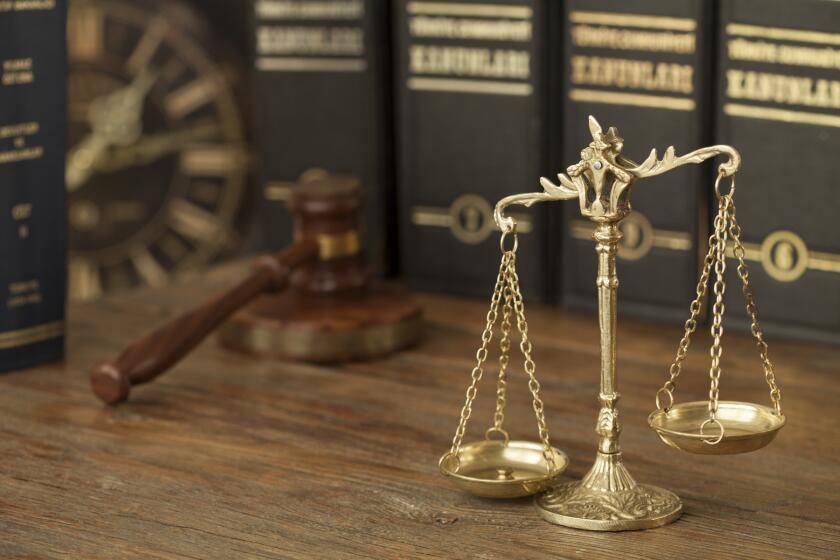Reading between the lines of festival art
- Share via
BOBBIE ALLEN
A ticket to the Pageant of the Masters always comes with a great perk
for art lovers: free admittance to the Festival of the Arts all
season long. If you go during the day, during the week, you can avoid
the crowds and wander at will. At night, you can often chat with the
artists.
It’s worth a special return trip, because amidst the countless
(but no doubt bestselling) California landscapes and (unaccountably)
numerous animal prints, there’s a chance to stroll through an
eclectic collection of artistic styles.
I have a taste for the unusual. This doesn’t necessarily mean
weird -- I loved photographer Dianne Reardon’s booth, for instance.
Reardon actually uses good old fashioned Kodak chemicals and makes
the prints herself. How marvelous! Her shots are simple, sometimes
haunting, even grainy. They stand out amid all that digital
hyper-perfection.
A few doors down from Reardon’s booth, you’ll find the mixed media
constructions of Pat Sparkuhl. These pieces are not to be missed
(although all the pointed and intelligent social commentary may give
you whiplash). “Missing Link” is a fascinating composition comprised
of bullet casings and a cut out of the iconic 1968 photo of the
execution of a Viet Cong officer. (Sparkuhl bravely posts an anti-war
statement with the work.) “Mind Over Matter” has a title that says it
all: it’s an 83-inch-high stack of those “free,” green-covered New
Testaments with a brain perched at the pinnacle. Fascinating, and a
little chilling.
If you go to Laurie Meinke’s booth of prints you can see the
difference between a photo etching, an etching on chine colle, a
linocut, a reductive linocut (“Tango las Ramblas -- very nice), and a
viscosity etching. Here is someone who studies her craft and isn’t
afraid to experiment.
If you like prints, there’s also Dirk Hagner, an artists whose
subject matter alone is enough to make him exemplary. It takes a lot
of guts to work words into art, because they have a tendency to
overwhelm the image. (You wouldn’t think this was true, but we’ll
read the words first and repeatedly, because we’re better mentally
equipped to interpret words as opposed to images.) Don’t miss
Hagner’s “Bertolt Brecht.” It’s a hand-painted woodcut of the poet
and playwright, written over in German. Hager’s work is masculine and
powerful -- focusing on appropriate subjects for his skill, like
Charles Bukowski. But my favorite in the booth is “Written
Landscape,” a small, hand-printed letterpress piece, where the word
“land” is repeated and closely knotted in cursive, and a
block-lettered “Me” floats above it, an ego on an island.
Donna Day Westerman also has some lovely prints, along with a
variety of other media, in her booth. “Anis/Back Bay” is a delicate,
large-scale study in how to use cross hatching to create soft lines.
But most interesting is Westerman’s use of tempura. Yes, that same
smelly egg-based paint you used in art class in junior high.
Westerman grinds her own pigments, and a work like “Young Elderberry”
makes use of the unusual colors that can result.
If you like portraiture, Bradford J. Salamon does frank, bright
studies of faces and figures that are brilliantly colored and full of
individuality. Lu Campbell does a very similar thing in the very
difficult medium of watercolor. Campbell’s portraits are highly
detailed, expertly done, and radiate warmth. Check out “Solving
Important Issues,” where two gray-haired gentlemen are deep in
conversation.
Paige Columbia Oden has a mixed media booth, but I was most
impressed by her unusual choice of oil on cast bronze in her
sculptures. “Gesturing in the Round” is a nude female torso with
strange texture and coloration, a very interesting interpretation of
an ancient subject.
Gerard Basil’s bronzes are also full of presence. “Totem” is a
collection three folded towers of patinaed metal. “Est ne Spes”
(which may be interpreted, in my rusty Latin, as questioning the
existence of hope) is a haunting piece of bronze. A chair sits in an
open wall, mounted off-center in concrete. The words of the title
appear in molten bronze, hovering over emptiness.
And finally, ceramics. Don’t miss Walter Reiss’s witty,
provocative, and occasionally blasphemous surreal teapots. My
favorite: “Faith-Based Teapot,” a white, unglazed pot that is topped
with three crosses and comes with the emblem, “There is no evidence
it can pour, but faith says it does.”
All this variety can be a bit overwhelming. Don’t be afraid to
stop and stare, to “read” the piece you’re looking at slowly and
carefully. True art always has a surprise waiting for you to find it.
All the latest on Orange County from Orange County.
Get our free TimesOC newsletter.
You may occasionally receive promotional content from the Daily Pilot.



